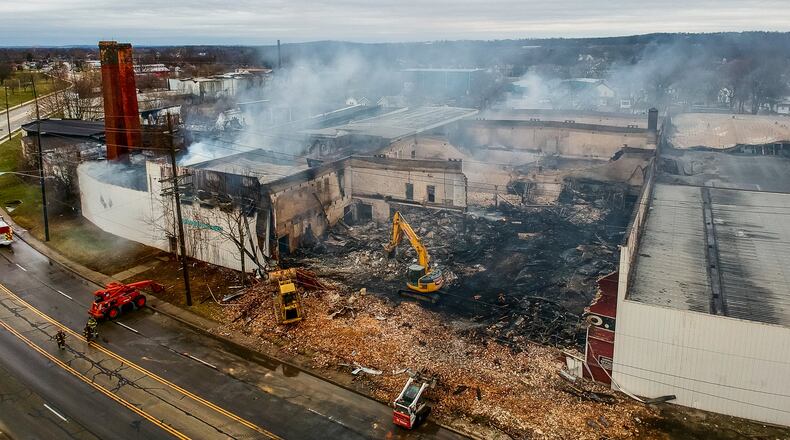The remaining $106 million in demolition and $262 million for brownfields will be disbursed “first come, first served” and requires a 25% match. Originally land bank officials thought they would be distributing the automatic $1.5 million in grants but when guidelines were released in December, county land banks were taken out of the brownfield disbursement.
Middletown and Hamilton have both applied directly for brownfield funds, $2.8 million and $1.2 million respectively. Middletown City Manager Jim Palenick said they applied for both the county’s $1 million allotment and some of the competitive monies to deal with the Paperboard building that was destroyed by a massive fire in 2020.
The county commissioners sent the state a letter of support for the Middletown Paperboard project but noted they will likely also send support letters if other jurisdictions apply.
“The board believes the city of Middletown’s project is ripe for funding and the city has taken the steps necessary to prepare for an efficient and safe cleanup,” the letter reads. “This grant could prove to be a powerful remedy in offsetting the technical, financial, and sequencing challenges the city of Middletown is facing.”
Hamilton Economic Development Specialist Stacey Dietrich said since they have already spent $1.53 million buying the Mohawk Fine Papers’ Beckett Mill property and doing preliminary work, they have satisfied the match requirement.
“I did not go after the county no-match dollars because we’ve spent money on that site that could be used as our match for that application,” Dietrich said. “I didn’t want to use up the county’s $1 million that doesn’t require a match.”
Middletown has already asked the county commissioners for $6.6 million of their $75 million in American Rescue Plan Act money for major redevelopment efforts including $2.38 million for the Paperboard site.
Commissioner Don Dixon said if Middletown gets some state money it should not influence their decision on ARPA funding.
“I would commend the city of Middletown for applying for this and I would not count this against them for any other monies that we have for this kind of remediation,” Dixon said. “I think it’s just a smart move on their part.”
The city also asked the commissioners for about $3.2 million to acquire, demolish and complete remediation of the 24-acre former AK Steel headquarters and research site and the old 19-acre CETA site, which would likely qualify for state remediation money. City Manager Jim Palenick said he did not apply for state brownfield funds for those projects.
“We know that there is a certain distribution that they’re not going to fund more than a certain amount for one particular jurisdiction,” Palenick said. “And what it would take alone for the Paperboard site is pretty substantial because it’s closing in on $3 million. So we felt the highest priority that we have, because of its condition and it’s immediate threat to its surroundings, is the Paperboard site.”
Dietrich said the funds they are seeking for the Mohawk site is to clean up asbestos and other harmful chemicals that have leeched into the soil, and possibly a small portion on the southern end that is structurally unsound will be demolished. The rest of the historic building will be redeveloped. They hope to apply for more funds but haven’t solidified those plans.
“There’s a couple locations, we know that we have some opportunity with the program,” Hamilton Economic Development Director Jody Gunderson said. “To be quite honest in some of the older cities you’re going to find we have more projects than we do money available. So we’ll have to take a look at our next round to see what makes sense for us and the ability to redevelop the property.”
The land bank has been collecting applications from all jurisdictions to utilize the $500,000 demolition money and the deadline to the state is Feb. 28. Executive Director Seth Geisler said they have 50 to 60 properties totaling about $1 million in the pipeline — not all have submitted applications yet — that could qualify for the state funds.
“Our cost estimates are just estimates and guestimates based on things in the past,” Geisler said. “We have a little over $1 million in the pipeline as far as projects. So our goal, if everything is ready go by the time I apply, is to figure out who gets the $500,000 guaranteed and how we do the match for the rest.”
There are about 30 properties in Hamilton, up to 18 in Middletown and around 14 from nine jurisdictions outside of the big cities.
The county has spent about $7.4 million in state and federal money tearing down approximately 750 eyesores since 2012. Those demolitions have been almost entirely in the two big cities and grant restrictions excluded commercial demolition.
Under the federal Hardest Hit Fund of the Neighborhood Initiative Program (NIP) the land bank received $4.3 million. Middletown reported in 2020 that in the previous four years they realized a 44% drop in police calls in the “NIP neighborhoods” and 51% lower drug overdose calls. The land bank report shows property values increased 47% in the areas were blight was banished.
Those federal and state grant monies are gone but the commissioners agreed to siphon 1 percent of DTAC funds, which are late payment penalties on real estate taxes, in 2014, which opened up land bank services to the rest of the county. The land bank has invested about $236,000 doing demolitions in Madison, Ross, St. Clair and Wayne townships, Fairfield, Hamilton, Middletown and Trenton with DTAC funds and has an account balance of just over $1 million.
About the Author

